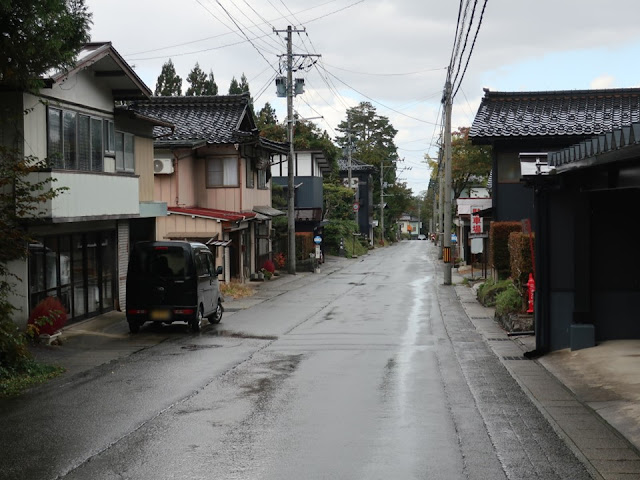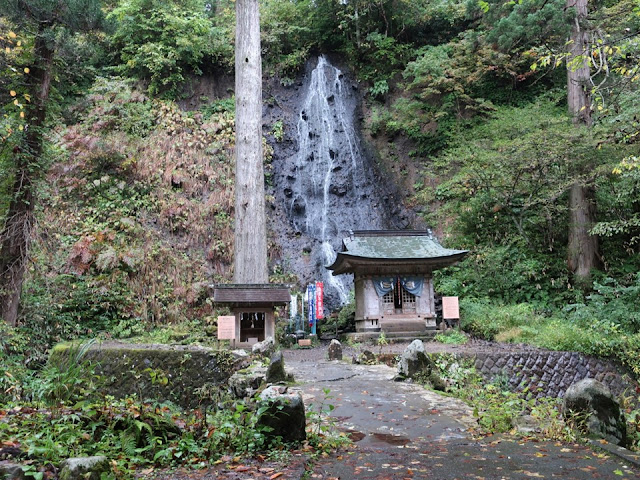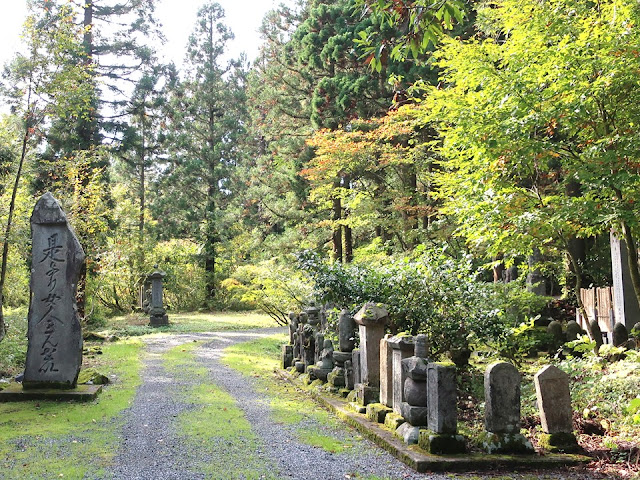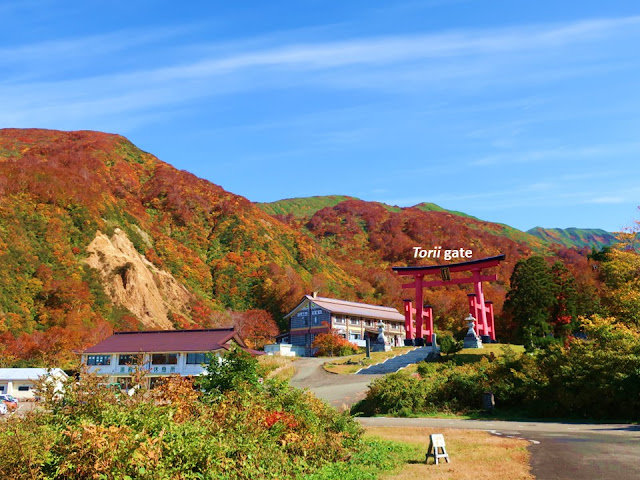It is written, “The Three Mountains of Dewa have been worshipped since days of old.
The journey through Mt. Haguro, Mt.
Gassan, and Mt. Yudono has come to be known as a passage through death to life.” People pray for their happiness at present in Mt. Haguro, did for
their ancestral spirits in Mt. Gassan and did for their future in Mt. Yudono.
It has been a popular pilgrimage since the Edo period (1603~1868) and been called “A Journey to Rebirth”.
I’d like to introduce the mountains and the
museum at the foot. This is a long post, but you'll feel familiar with “Three
Mountains of Dewa” after reading.
Japan Heritage Site, Three Mountains of Dewa https://nihonisan-dewasanzan.jp/en/
日本遺産 出羽三山 https://nihonisan-dewasanzan.jp/, accessed in January, 2023
出羽三山の旅は、現世の幸せを祈る羽黒山、祖霊が鎮まる月山(過去を祈る)、お湯が湧き出す御神体が生命の誕生を現す湯殿山(未来を祈る)を巡る旅です。江戸時代から「生まれ変わりの旅」と言われ、人気の巡礼コースでした。羽黒山の参詣口にある資料館とともに紹介します。長い記事ですが、読んでいただけると出羽三山が身近になると思います。
There is a big torii gate on the way to Mt. Haguro.
羽黒山大鳥居。鶴岡の街から羽黒山に向かう道にあります。
Touge, a town of pilgrim lodges (Shukubou)、門前町・手向(とうげ)
There are seven towns of pilgrim lodges around Mt. Haguro; Touge is the major one. The photo above “Ohta-bou” is one of Shukubou inns in Touge which has a lager building in behind (upper right). Until 1884, pilgrims had to follow a sendachi guide of Shukubou inns when they climbed the Three Mountains. The building on the right is Ohgon Hall of Shouzenin-temple built in 1193.
門前町・八方七口の一つ、手向(とうげ)は羽黒山へのメインの登拝口です。今も宿坊が並びます。太田坊の奥には大きな宿舎のような建物があります(右上)。かつては、宿坊の先達に従って登拝しましたが、明治17年に山先達を伴わない登拝が許されました。右側のお堂は正善院の黄金堂(1193年建立)です。
It is also Shukubou inn “Ohtsuka” which is dozens of meters away from the main street. It has a sacred rope above the entrance which prevents the building from fire and drives away demons.
こちらも宿坊「檀所院大塚」さん。街道から数十m入ります。火防せと悪魔退散の引き綱が玄関の上に掲げられています。
I proceeded the main street in which Shukubou inns are.
宿坊が並ぶ手向の町を進みます。
Ideha Cultural Museum、いでは文化記念館
The museum is near the approach to Mt. Haguro. It is as large as a gymnasium in school; it has a lot of exhibits including full-scale models. However, it’s a pity that photography is prohibited. I’d like to introduce using its brochure I was given at the museum.
羽黒山の入口にあります。体育館規模の展示室で、模型や資料が充実していますが、撮影禁止で残念。いただいたパンフレットの写真と文で紹介します。
Four models of Yamabushi (mountain priests, photo in center) and their outfits including a ritual one (Takadera-hakkou) are exhibited. The full-scale model of the hut in which Bashou (the greatest master of haiku short poetry) lodged in the summer of 1689 is also exhibited.
Meals served in Shukubou inn are impressive (lower left). Those are vegetarian dishes called “Shoujin(devotion)-ryouri(cuisine)”. Yamabushi priests or pilgrims eat them before climbing in order to purify themselves. There were more than three hundred Sukubou in Touge, but there are less than thirty now. Cooking and preserving “Shoujin-ryori” strengthen the tie among people in Touge, where the number of pilgrims is decreasing. On the other hand, many tourists or climbers visit now. (Reference, Shoujin-ryouri:https://www.youtube.com/watch?v=fwec4d1T_Z0&t=49s)
常設展示室には、山伏の模型四体(写真中央)、芭蕉も泊まったという笹小屋の実物模型があります。芭蕉は。1689年6月3日(新暦7月19日)から10日までの7泊の行程で、出羽三山に参りました。
山伏・道者の装束/出で立ち、高寺八講(たかでらはっこう)などの行事の装束も展示されています。
宿坊の精進料理の模型が印象的(写真左下)。山伏や行者にとって、精進料理は、これから山に入るという禊ぎでした。手向の宿坊は、江戸時代には300を越えましたが、今は30に満たないそうです。シアターでは、精進料理作りの伝統を守る活動で、手向の人々のつながりが強化されたと紹介されています。(精進料理の動画:https://www.youtube.com/watch?v=fwec4d1T_Z0&t=49s)
Many movies and photos of mountain priest’s training are displayed. Old photos attracted me such as rest stations; nine stations were located in the way to the summit of Mt. Gassan at almost equal interval. The tenth one is near the summit. Each station had its special meal or sweets which were important to gather guests. Therefore, the specialties were designated by the pilgrimage management temple (Bettou). The models of meals are exhibited, too.
Medicinal plants and its bath houses were also introduced. Those were good cause to visit the high mountain, Gassan.
修験修行のビデオ、写真が充実していました。特に、古写真が興味深いです。月山の一合目毎に置かれた小屋の写真があり、そこで売られた食べ物の模型もあます。客集めでもあるので、別当が名物を決めたそうです。
月山で採れる薬草と薬湯小屋の紹介も印象的で、月山に行く理由を作ってくれたと思います。
The greatest local festival is “Shou-rei-sai”. Two highest rank Yamabushi priests have an ascetic training for a hundred days. The last day is the New Year's Eve. On the day, residents of two towns in Touge area fight to pull and get the torch above.
https://www.youtube.com/watch?v=IxF6sG2Wxok&t=155s, the event starts at 3 minutes and ten seconds on the video.
The ropes which were used in the event are set above the entrances of Shukubou inns, restaurants and so on (lower right). The black part is dyed hemp which means the dragon god in the pond of Mt. Haguro.
A foreign photographer in the video above says, “rediscovering myself in nature” (at 2 minutes and 30 seconds). I felt the same thing while climbing the approach to Mt. Haguro.
最大の祭りの松例祭。修験者の最高位の松聖(まつひじり、二人)は、100日の行に入り、大晦日に満願になります。このとき、手向地区の二つの町が大松明を引き合います(上の写真/松例祭保存会のパンフレット)
ビデオ(3分10秒から大松明行事):https://www.youtube.com/watch?v=IxF6sG2Wxok&t=155s
綱(右下)は、魔除けとして玄関に飾られます。宿坊や店では必ずといって良いほど付けていました。黒い部分は、麻を黒く染めたもので、三神合祭殿(羽黒山)前の鏡池の龍神様を表します。
上記のビデオの中で、修験者を撮影し続ける外国人が「自然の中で自分を見つける」と言っていた(2分30秒頃)がとても印象的でした。参道を登っていくと、私も同じことを感じました。
Reference site: Ideha Cultural Museum、出羽三山といでは文化記念館 https://hagurokanko.jp/p26/ (in Japanese), accessed in January, 2023
Mt. Haguro、羽黒山
I visited Mt. Haguro (praying for the present happines) at first, then visited Mt. Gassan (praying for the ancestors’ spirits), and finally visited Mt. Yudono (praying for the future). It has been a mainstream route since old days.
I went through the gate of Mt. Haguro "Zuishin-mon" (above).
江戸時代からの巡礼コースに従い、現在(羽黒山)、過去(月山)、未来(湯殿山)の順で出羽三山を巡りました。羽黒山・随神門に入ります。
There is a downslope just behind the gate.
門をくぐると階段を降りていきます。
Soon, we can see a bridge.
すぐに、祓川神橋が見えてきます。
We can see Suga Fall from the bridge. It is a place to purify ourselves before we visit the shrine. It seems to be natural, however it was made by construction work. The head monk Tenyu (1593?-1674) did it; he also built stone steps and planted cedar trees beside the approach. The place is popular even until now.
橋からは、須賀の滝が見えます。禊ぎをする場所ですが、実は、江戸初期に羽黒山を本山(天台宗の末寺)とした天宥(1593?-1674)が、川を引いてきて滝にしたものです。石段や杉並木とともに整備したそうです。死後の世界へ入る三途の川とも見立てられています。
It is an artificial fall but divine.
400年前に作られた滝ですが、神々しさを感じます。
The five-storied pagoda, which was designated a national treasure, was rebuilt around six hundred years ago. It will be covered by scaffolds from 2023 to 2025 (spring) because of roof renovation. Most of tourists turn back to their bus here, and go to the top of the mountain.
国宝の五重塔。五重塔があるのに神社。明治の神仏分離令の影響の大きさを実感します。2023年から2025年春頃まで屋根の改修工事に入り、足場で覆われます。多くの観光客はここで引き返して、バスで山頂の神社を訪れます。
Let’s go up the approach. It is called “The first slope (hill)”.
表参道の一の坂が始まります。
After a short flat path, there is “The second slope”.
少し平坦地があって二の坂。
When I felt tired with climbing, I could find the teahouse at the end of the second slope.
キツいなあと思った頃に、二の坂茶屋が見えてきました。
I had maccha tea (right), sweets (mochi cakes, behind), pickled radish (behind) and normal tea (houjicya, left). Sweets are definitely feast when we are tired. Plus, the price is not expensive (650 yen in 2022). The shop owner makes mochi cakes every morning and climbs up to the teahouse. It was fun to talk with her.
毎朝、店でついて作る力餅(きな粉&あんこ)と抹茶、ほうじ茶をいただきました。疲れた時に甘い物はいいですねえ。しかも、リーズナブルな値段設定(650\、2022年)。大根の漬物も嬉しかった。毎朝、食べ物を持って登ってくるお店の人との会話が楽しかったです。
The photo above is a view from the teahouse, which is the sole viewpoint on the way.
そして、この景色。羽黒山表参道の唯一の展望場所です。
I walked on the flat path. There was a residence of a head monk in the past.
茶屋からは平坦地が続きます。御本坊跡が右側にあり、その先に芭蕉も泊まった南谷があります。
At the peak of the slope, there is “Saikan” which is famous for “Shoujin(devotion)-ryouri(cuisine)” <reservation is required>. People eat vegetarian dishes, purify themselves, then visit the shrine.
三の坂を登ると斎館があります。精進料理が有名です。精進料理(予約制)を食べ、身を清め、山に向かう気持ちを整えます。
I continued climbing, and found the tori gate which is the end of the slope of 2,446 stone steps. I reached to the top of Mt. Haguro (414m). It took around one hour except for resting at the teahouse.
I met a few walkers including two foreigners because most visitors use a car or a bus. BUT, I strongly recommend you to walk. The sacred path, on which many people have walked since old time, moves us a lot.
斎館を過ぎると間もなく、鳥居。2,446段の石段を登り終え、羽黒山山頂(414m)に着きます。随神門から休憩を除いて一時間の行程です。
この日、歩いて登っている人と会ったのは数人でした。多くの人は車で登りますが、この神聖な階段、かつ、先人の足音を感じる階段、とてもお勧めです。
Behind the torii gate, there is Sanjin Gōsaiden which is the main shrine building. It enshrines three deities in Dewa (Mt. Haguro, Mt. Gassan, and Mt. Yudono) together. The pond in front of the building is called “Kagami(mirror)-ike(pond)”; it is said that a dragon resides in it.
Dewa area had flourished as one of the centers of “Shugen-dou” (mountain worship) and a management temple (Buddhism) was built at each starting point for an ascent. However, after the shogunate was abolished in 1867, the new government prioritized on Shintoism and removed other religious things from the site. At that time, Dewa changed from Shugen-dou to Shintoism. It’s a complex history influenced by politics.
鳥居の先には、三神合祭殿。茅葺きです。その前には、龍が棲むという鏡池があります。出羽三山は、山岳信仰を体系化した修験道で発展し、登り口には寺(別当寺)が置かれましたが、明治維新で、神道への衣替えとなりました。複雑な歴史を持っています。(ご参考:出羽三山-山岳信仰の歴史を歩く(岩鼻通明、2017、岩波新書)
There are three boards above the place of worship (from the left, Yudono-san Shrine, Gassan Shrine and Dewa Shrine). Three deities are exactly enshrined together.
月山神社を中央に、湯殿山神社、出羽神社の額が掲げられています。まさに、三神合祭殿です。
Mt. Gassan、月山
There is Koutakuji (temple) at the starting point.
月山登拝道の荒澤寺。今は無住で、手向の正善院が管理しています。
Behind the temple, there is a path to climb the mountain. It is written, “Off limit for women” on the stone monument on the left. Women used to be forbidden to climb this mountain. I climbed by car next day.
門をくぐり、お堂を過ぎると、「是より女人きんせい」の石柱があります。月山は車で登りました。出羽三山の内、月山と湯殿山は女人禁制、羽黒山は昔から女人も登れました。
I headed to the summit via a winding road, however the fog prevented me from meeting with Mt. Gassan. I turned back from the highest carpark.
翌日、月山山頂を目指しましたが、ガスがかかり、八合目の駐車場にて断念。残念。
On the following day, I could see Mt. Gassan (1984m) from the Shounai Plain.
次の日、鶴岡側から月山(1984m)を見ることができました。
Mt. Yudono、湯殿山
I visited Mt. Yudono under the clear sky. The leaves were starting to turn. There is a great red torii gate and a lodge for pilgrims beside it. You can stay there.
晴天の中、紅葉が始まった湯殿山へ向かいました。大鳥居がありその横に参籠所があります。宿泊できます。
I got on a small bus and got to the terminal. Everyone has to walk to the shrine, and photography is prohibited from there because it’s a deity’s territory. I walked for a while, and took off shoes and socks. I was purified by a priest. Then, I proceeded to the great rock from which the warm water flows; it is believed the deity resides there. I felt greatest power in my whole life, and prayed.
By the way, it is said, “You don’t talk about it to others even if you are asked. You don’t listen to the experience if someone tries to talk to you”. So, I’d like to stop writing here. You can see the way to the great rock at the next video (from 1 minute and 30 seconds, English narration).
大鳥居から専用バスで登っていくと、撮影禁止の看板があります。この先は神域です。「(聞かれても)語るなかれ、(語っても)聞くなかれ」といわれた湯殿山の御神体へと向かいます。
お祓いを受け、温泉成分が固まった巨岩の御神体に参ります。これまで感じたことがないほどの強いパワーを感じました。
御神体手前までと参拝後の足湯は、次のビデオの1分30秒から拝見できます。 https://www.youtube.com/watch?v=IxF6sG2Wxok
I returned by bus to the carpark. The driver announced, “Please go under the torii gate and go back”. I know why "Three Mountains of Dewa" has been so popular among ordinary people for a long time in my journey. It’s an unforgettable visit.
バスで降りてくると、「鳥居をくぐってお帰りください」とアナウンスがありました。出羽三山が、江戸時代から人気だったことが実感できました。忘れられない参拝です。
Visited in October, 2022
Japan Heritage Site, Three Mountains of Dewa https://nihonisan-dewasanzan.jp/en/、日本遺産 出羽三山 https://nihonisan-dewasanzan.jp/
Previous post (museum in the same city): Chido Museum (2/2)、致道博物館 part2
Next post (museum in the neighboring city): Sakata city museum、酒田市立資料館































Comments
Post a Comment